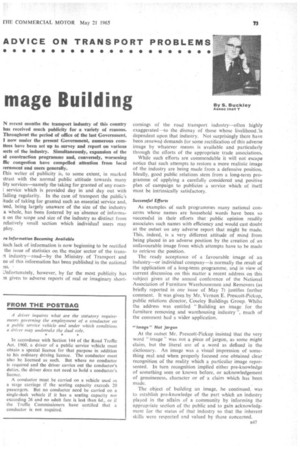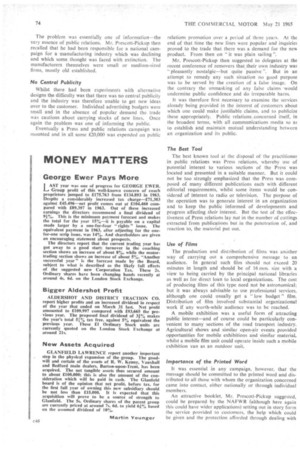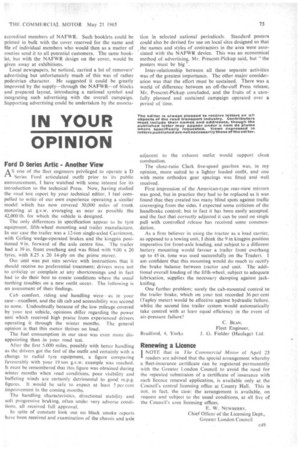ADVICE ON TRANS PORT PROBLEMS
Page 75

Page 76

Page 77

If you've noticed an error in this article please click here to report it so we can fix it.
mage Building
By S. Buckley
Assoc Inst T
N recent months the transport industry of this country has received much publicity for a variety of reasons. Throughout the period of office of the last Government, d now under the present Government, numerous corn(tees have been set up to survey and report on various wets of the industry. Simultaneously, expansion of the id construction programme and, conversely, worsening ffic congestion have compelled attention from local vernment and users generally.
This welter of publicity is, to some extent, in marked itrast with the normal public attitude towards many lity services—namely the taking for granted of any essen
service which is provided day in and day out with failing regularity. In the case of transport the public's itude of taking for granted such an essential service and, teed, being largely unaware of the size of the industry a whole, has been fostered by an-absence of informan on the scope and size of the industry as distinct from relatively small section which individual users may ploy.
re information Becoming Available
;Lich lack of information is now beginning to be rectified the issue of statistics on the major sector of the transrt industry—road—by the Ministry. of Transport and ne of this information has been published in the national !ss.
Unfortunately, however, by far the most publicity has m given to adverse reports of real or imaginary short
comings of the road transport industry—often highly exaggerated--to the dismay of those whose livelihood:is dependent upon that industry. Not surprisingly there have been renewed demands for some rectification of this adverse image by whatever means is available and particularly through the efforts of the appropriate trade associations.
While such efforts are commendable it will not escape notice that such attempts to restore a more realistic image of the industry are being made from a defensive position. Ideally, good public relations stem from a long-term programme of applying a carefully considered and positive plan of campaign to publicize a service which of itself must be intrinsically satisfactory.
Successful Efforts
As examples of such programmes many national concerns whose names are household words have been so successful in their efforts that public opinion readily associates such names with efficiency and would cast doubt at the outset on any adverse report that might be made. This, indeed, is a very different attitude of mind from being placed in an adverse position by the creation of an • unfavourable image from which attempts have to be made to retrieve the position.
The ready acceptance of a favourable image of an industry—or individual company—is normally the result of the application of a long-term programme, and in view of current discussion on this matter a recent address on this subject given at the annual conference of the National Association of Furniture Warehousemen and Removers (as briefly reported in our issue of May 7) justifies further comment. It was given by Mr. Vernon E. Prescott-Pickup, public relations director, Coseley Buildings Group. Whilst the address was entitled "Building an image for the furniture removing and warehousing industry much of the comment had a wider application.
"Image" Not Jargon
At the outset Mr. Prescott-Pickup insisted that the very word " image " was not a piece of jargon, as some might
claim, but the literal use of a _word as defined in the dictionary. An image was a visual impression of something real and when properly focused one obtained clear recognition of the reality which a particular image represented. In turn recognition implied either pre-knowledge of something seen or known before, or acknowledgement of genuineness, character or of a claim which has been made.
The object of building an image, he continued, was to establish pre-knowledge of the part which an industry played in the affairs of a community by informing the appropriate section of the public and to gain acknowledgment for the status of that industry so that the inherent skills were respected and valued by those concerned. The problem was essentially one of information—the very essence of public relations. Mr. Prescott-Pickup then recalled that he had been responsible for a national campaign for a manufacturing industry which was declining and which some thought was faced with extinction. The manufacturers themselves were small or medium-sized firms, mostly old established.
No Central Publicity Whilst there had been experiments with alternative designs the difficulty was that there was no central publicity and the industry was therefore unable to get new ideas over to the customer. Individual advertising budgets were small and in the absence of popular demand the trade was cautious about carrying stocks of new lines. Once again the problem was one of informing the public.
Eventually a Press and public relations campaign was mounted and in all some £20,000 was expended on public relations promotion over a period of three years. At the end of that time the new lines were popular and inquiries proved to the trade that there was a demand for the new product. From then on "it was plain sailing ".
Mr. Prescott-Pickup then suggested to delegates at the recent conference of removers that their own industry was "pleasantly nostalgic—but quite passive ". But in an attempt to remedy any such situation no good purpose was to be served by the creation of a false image. On the contrary the unmasking of any false claims •would undermine public confidence and do irreparable harm.
It was therefore first necessary to examine the services already being provided in the interest of customers about which one could make justifiable claims, and to publicize these appropriately. Public relations concerned itself, in the broadest terms, with all communications media so as to establish and maintain mutual understanding between an organization and its public.
The Best Tool The best known tool at the disposal of the practitioner in public relations was Press relations, whereby use of potential interest to various sections of the Press was located and presented in a suitable manner. But it could not be too strongly emphasized that the Press was composed of many different publications each with different editorial requirements, whilst some items would be considered of interest to radio or television. The purpose of the operation was to generate interest in an organization and to keep the public informed of developments and progress affecting their interest. But the test of the effectiveness of Press relations lay not in the number of cuttings extracted from publications but in the penetration of, and reaction to, the material put out.
Use of Films
The production and distribution of films was another way of carrying out a comprehensive message to an audience. In general such film should not exceed 20 minutes in length and should be of 16 mm. size with a view to being carried by the principal national libraries as well as for direct loan to local organizations. The cost of producing films of this type need not be astronomical; but it was always advisable to use professional services, although one could usually get a "low budget" film. Distribution of film involved substantial organizational work if any worth-while audience was to be reached.
A mobile exhibition was a useful form of attracting public interest—and of course could be particularly convenient to many sections of the road transport industry. Agricultural shows and similar open-air events provided opportunities for mobile exhibitions and similar material, whilst a mobile film unit could operate inside such a mobile exhibition van as an outdoor unit.
Importance of the Printed Word It was essential in any campaign, however, that the message should be committed to the printed word and distributed to all those with whom the organization concerned came into contact, either nationally or through individual members.
An attractive booklet, Mr. Prescott-Pickup suggested, could be prepared by the NAEWR (although here again this could have wider applications) setting out in story form the service provided to customers, the help which could be given and the protection afforded through dealing with accredited members of NAFWR. Such booklets could be printed in bulk with the cover reserved for the name and file of individual members who would then as a matter of routine send it to all potential customers. The same booklet, but with the NAFWR design on the cover, would be given away at exhibitions.
Local newspapers, he noticed, carried a lot of removers' advertising but unfortunately much of this was of rather pedestrian character. He suggested it could be greatly improved by the supply—through the NAFWR—of blocks and prepared layout, introducing a national symbol and integrating such advertising with the overall campaign. Supporting advertising could be undertaken by the associa tion in selected national periodicals. Standard posters could also be devised for use on local sites designed so that the names and styles of contractors in the area were associated with the NAFWR device. This was an economical method of advertising, Mr. Prescott-Pickup said, but "the posters must be big ".
Inter-relationship between all these separate activities was of the greatest importance. The other major consideration was that the effort must be sustained. There was a world of difference between an off-the-cuff Press release, Mr. Prescott-Pickup concluded, and the fruits of a carefully planned and sustained campaign operated over a period of time.
FROM THE POSTBAG A driver inquires what are the statutory requirements governing the employment of a conductor on a public service vehicle and under which conditions a driver may undertake the dual role.
In accordance with Section 144 of the Road Traffic Act, 1960, a driver of a public service vehicle must obtain a special licence for that purpose in addition to his ordinary driving licence. The conductor must also be licensed as such. But where no conductor is required and the driver carries out the conductor's duties, the driver does not need to hold a conductor's Licence.
A conductor must be carried on a vehicle used as a stage carriage if the seating capacity exceeds 20 passengers. But no conductor need be carried on a single-deck vehicle if it has a seating capacity not exceeding 26 and no adult fare is less than 6d.. or if the Traffic Commissioners have certified that a conductor is not required.
IN YOUR OPINION
The editor is always pleased to receive letters on all aspects of the road transport industry. Contributors must Include their names and addresses, though the published letter may appear under a nom de plume where specifically requested. Views expressed in letters published are not necessarilythose of the editor.
Ford D Series Artie Another View
AS one of the fleet engineers privileged to operate a D
Series Ford articulated outfit prior to its public announcement, I have watched with some interest for its introduction to the technical Press. Now, having studied the road test report by your technical editor, I feel compelled to write of our own experience operating a similar model which has now covered 30,000 miles of trunk motoring at g.v.w. averaging as near as possible the 42,000 lb. for which the vehicle is designed.
The only differences in specification appear to be tyre equipment, fifth-wheel mounting and trailer manufacture. In our case the trailer was a 12-ton single-axled Carrimore, with Girfing wedge-operated brakes and the kingpin positioned 9 in. forward of the axle centre line. The trailer had a 39 in. front overhang and was fitted with 9.00 x 20 tyres, with 8.25 x 20 14-ply on the prime mover.
Our unit was put into service with instructions that it should receive no preferential treatment; drivers were not to criticize or complain at any shortcomings and in fact had to do their best to create conditions where the usual teething troubles on a new outfit occur. The following is an assessment of their findings.
Cab comfort, riding and handling Were—as in your case—excellent, and the tilt cab and accessibility was second to none. Undoubtedly because of the low mileage covered by your test vehicle, opinions differ regarding the power unit which received high praise from experienced drivers operating it through the winter months. The general opinion is that this motor thrives on load.
The fuel consumption in our case was even more disappointing than in your road test.
After the first 5,000 miles, possibly with better handling as the drivers got the feel of the outfit and certainly with a change to radial tyre equipment, a figure comparing favourably with your 19 ton g.v.w. example was reached. It must be remembered that this figure was obtained during winter months when road conditions, poor visibility and buffeting winds are certainly detrimental to good m.p.g. figures. It .would be safe to expect at least 5 pe r cent improvement in the coming months.
The handling characteristics, directional stability and soft progressive braking, often under very adverse conditions, all received full .approval In spite of constant look out no black smoke reports have been received and examination of the chassis and axle adjacent to the exhaust outlet would support clean combustion.
The close-ratio Clark five-speed gearbox was, in my opinion, more suited to a lighter loaded outfit, and one with more orthodox gear spacings was fitted and well received.
First impression of the American-type rear-view mirrors was good, but in practice they had to be replaced as it was found that they created too many blind spots against traffic converging from the sides. I expected some criticism of the handbrake control; but in fact it has been easily accepted, and the fact that correctly adjusted it can be used on single pull with controlled release has received some commendation.
As a firm believer in using the tractor as a load carrier, as opposed to a towing unit, I think the 9 in kingpin position imperative for front-axle loading, and subject to a different battery mounting would favour a trailer front overhang up to 45 in. (one was used successfully on the Trader). I am confident that this mounting would do much to rectify the brake balance between tractor and unit. The additional overall loading of the fifth-wheel, subject to adequate lubrication, supplies the necessary damping against jackknifing.
One further problem; surely the cab-mounted control to the trailer brake, which on your test recorded 36 per cent (Tapley meter) would be effective against hydraulic failure, whilst the second line trailer system would automatically take control with at least equal efficiency in the event of air-pressure failure?
C. BEAN, Fleet Engineer, k radio rd, 4, Yorks J. G. Fielder (Haulage) Ltd.
Renewing a Licence
I NOTE that in The Commercial Motor of April 23
readers are advised that the special arrangement whereby a fleet-insurance certificate can be registered permanently with the Greater London Council to avoid the need for the repeated submission of a certificate of insurance with each licence renewal application, is available only at the Council's central licensing office at County Hall. This is not, in fact, the case: the arrangement is available, on request and subject to the usual conditions, at all five of the Council's area licensing offices.
E. W. NEWBERRY, Chief Officer of the Licensing Dept., Greater London Council
MONEY MATTERS
George Ewer Pays More
I AST year was one of progress for GEORGE EWER. 1-. Group profit of this well-known concern of coach proprietors jumped to 1175,763 from 1134,893 in 1963. Despite a considerably increased tax charge—f 71.303 against f45,496—net profit comes out at £104,469 compared with 189,397 in 1963. Out of these increased earnings the directors recommend a final dividend of 91%. This is the minimum payment forecast and makes the total for the year 15%—it is payable on a capital made larger by a one-for-four "rights" issue. The equivalent payment in 1963, after adjusting for the onefor-one scrip issue, was 14%. And shareholders are given an encouraging statement about prospects.
The directors report that the current trading year has got away to a good start; turnover in the coaching section shows an increase of about 8%, while the motortrading section shows an increase of about 5%. "Another successful year" is the forecast made by the Board, subject to what is described as the likely full effects of the suggested new Corporation Tax. These 2s. Ordinary shares have been changing hands recently at around 4s. 6d. on the London Stock Exchange.
Bigger Aldershot Profit
ALDERSHOT AND DISTRICT TRACTION CO. report higher profits and an increased dividend in respect of the year that ended on March 31 last. Net profit amounted to £109,997 compared with 193,665 the previolas year. The proposed final dividend of 31% makes the year's total 54% tax free, against 5% equivalent the previous year. These LI Ordinary Stock units are currently quoted on the London Stock Exchange at around 21s.
New Assets Acquired
GLANFIELD LAWRENCE report another important step in the physical expansion of the group. The goodwill and certain of the assets of R. W. Kenny, Vauxhall and Bedford main dealers, Burton-upon-Trent, has been acquired. The net tangible assets thus secured amount to about 1100,000; this is also the amount of the consideration which will be paid in cash, The Glanfield board is of the opinion that net profit, before tax, for the first full year of owning this new subsidiary should be not less than £15,000. It is expected that this acquisition will prove to be a source of strength to Glantield. The 5s. Ordinary shares of the parent group are currently priced at around 7s. 6d. to yield 611% based on the assumed dividend of 10%.
Martin Younger
























































































































